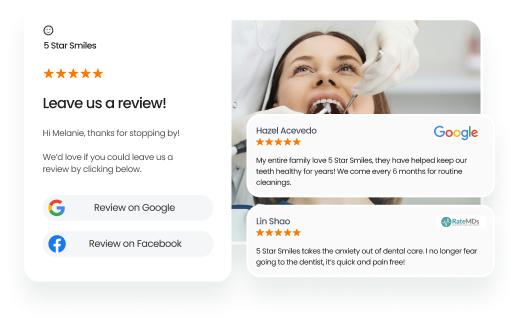In 2025, online reviews carry more weight than ever, shaping consumer decisions, search rankings, and overall brand trust. But getting those reviews still hinges on one crucial step: asking.
For most businesses, SMS and email remain the two go-to review request channels. Both have their strengths, but which one actually works better in today’s digital landscape?
This post explores the impact of SMS vs. email review requests in 2025—backed by new data from Birdeye’s annual State of Online Reviews 2025 report. Using this exclusive dataset, we’ll break down what businesses should consider when choosing the right review request channel (or combination) to get more reviews from happy customers.
Table of contents
- Understanding SMS & email review request channels
- The case for SMS review requests
- The case for email review requests
- SMS vs. email: Key performance comparison
- How to request reviews: A multi-channel approach
- Additional tips for using a combination of SMS and email
- Frequently asked questions about SMS vs. email review requests
- How Birdeye helps businesses with a multi-channel review request strategy
Understanding SMS & email review request channels
SMS
SMS remains one of the fastest and most direct review request channels. When you send a review request via text, it reaches your customers instantly. However, 2025 has seen a notable shift. While SMS remains attention-grabbing, fewer people are clicking review links. The reasons? Increased message fatigue, spam filters, and AI-generated scam texts have all contributed to a decline in trust and interaction.
Email is a long-standing champion among review request channels. It offers rich branding, detailed messaging, and personalization. But inboxes are more crowded than ever, and standing out takes effort. Still, businesses favor email as a reliable way to request reviews. It’s scalable, trackable, and integrates easily with CRMs and automation tools.
The case for SMS review requests
Text messages grab attention fast—Statista. They’re ideal for mobile-first consumers and immediate post-purchase engagement. But is SMS still winning in the SMS vs. email review requests comparison?
New data from Birdeye’s State of Online Reviews 2025 report shows that:
- Click-through rates (CTR) dropped from 8% in 2023 to just 6% in 2024.
- In February 2025, over 19.2 billion spam texts were recorded, and AI-driven scams have made users more cautious about clicking links.
- Stricter carrier filtering and evolving compliance regulations limit the reach of even legitimate business texts.
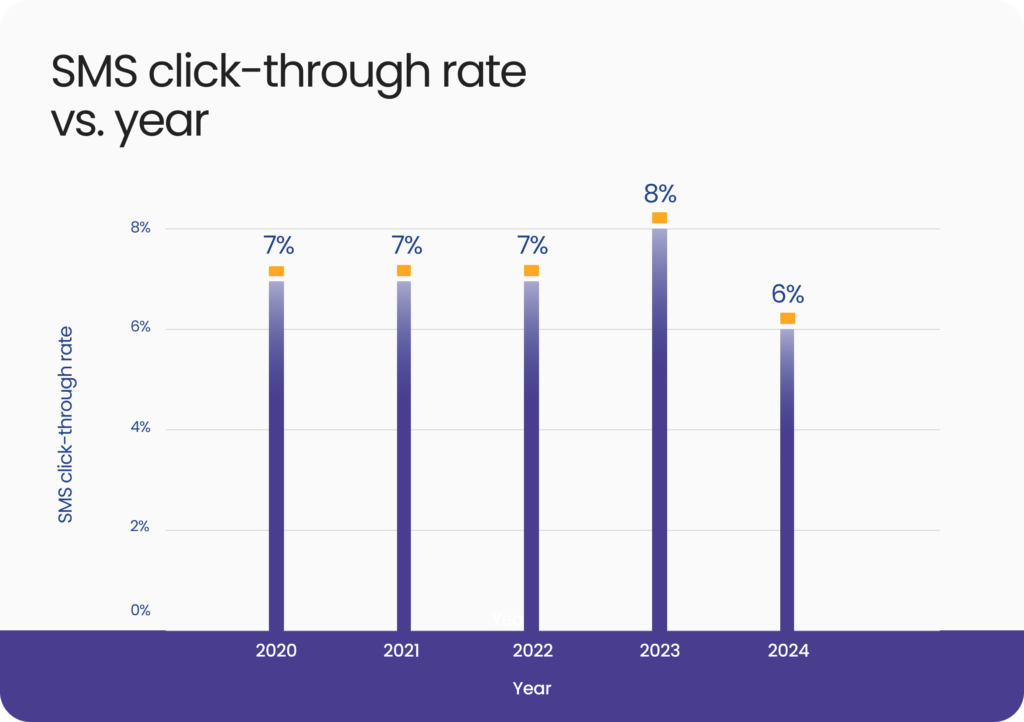
Best practices for SMS review requests
To improve results, focus on clarity and personalization. A great SMS review request includes:
- A personalized greeting (“Hi John!”)
- A short, friendly ask (“We’d love your feedback!”)
- A direct review link
Examples of SMS review requests
- Hi Sarah! Thanks for visiting today 😊 We’d love your feedback—please leave us a quick review here: [Review Link]
- Hi James! Thanks for choosing [Business Name] today. Your opinion matters to us—mind leaving a quick review? It only takes a minute: [Review Link]
Looking to explore how to choose the best review request channel for your business and boost your online reputation? Check out Birdeye’s annual State of Online Reviews 2025 report for exclusive insights and actionable recommendations.
The case for email review requests
Despite being less immediate, Birdeye’s State of Online Reviews 2025 report shows that email review requests remain the top choice for businesses, accounting for 60% of all review requests in 2025. In the SMS vs. email review requests debate, email holds strong because of:
- Brand engagement: Emails allow businesses to include their logo, colors, and tone of voice, helping reinforce their brand.
- Personalization: It’s easy to tailor emails with the customer’s name and specific details, making the message feel more personal.
- Detailed messaging and design: Emails can include more content, images, and links, giving customers all the info they need in one place.
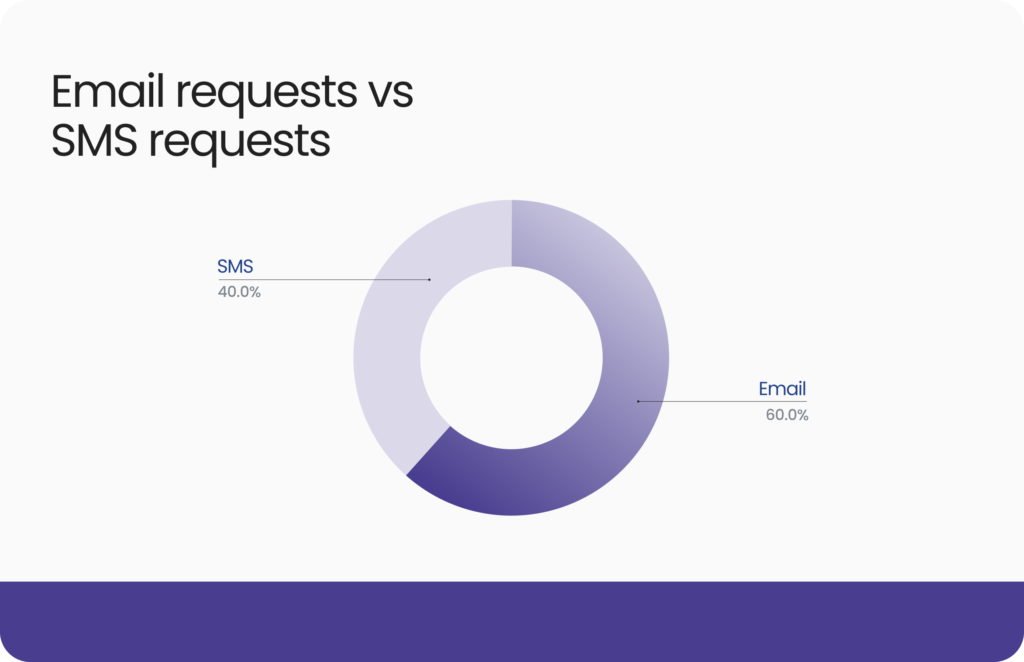
Email is a more effective review request channel for long-term engagement and nurturing customer relationships. In addition, email open rates have remained consistent in 2025.
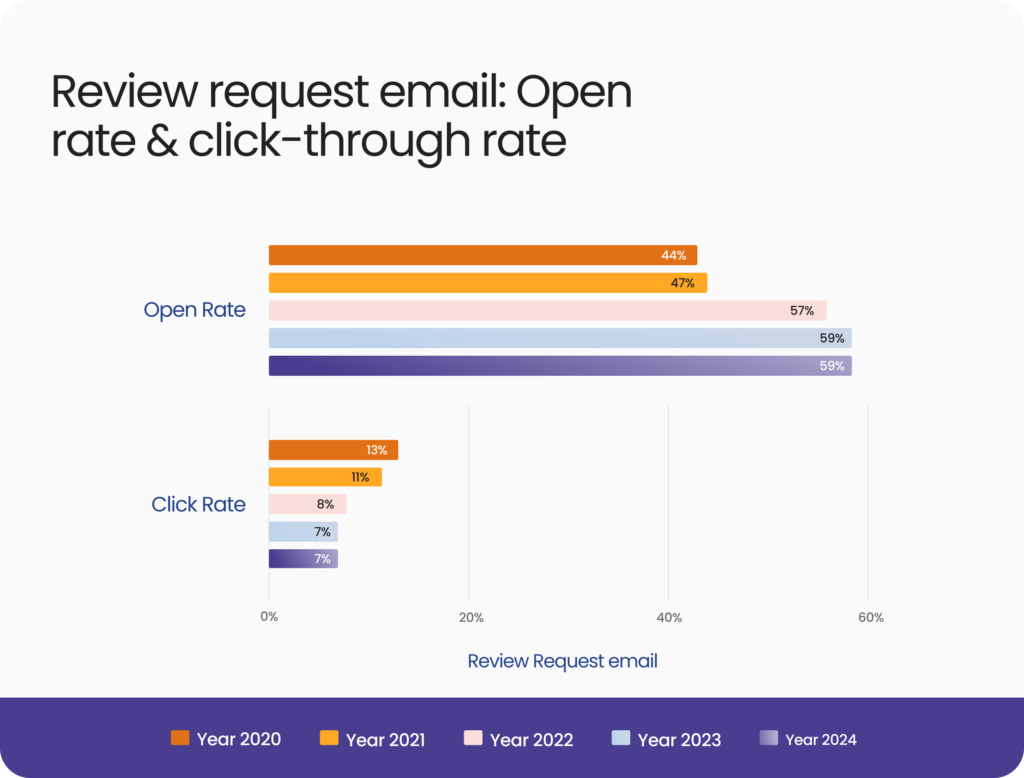
Best practices for email review requests
- Use a compelling subject line like “We’d love your feedback” or “How did we do?”
- Don’t overload the email with too much text & add a clear CTA.
- Make sure your email layout is mobile-friendly with easy-to-click buttons.
Examples of email review requests
1. Subject line: “We’d love your feedback, Anna!”
Body:
Hi Anna,
Thank you for choosing [Business Name]. We’d really appreciate it if you could take a minute to share your experience with us.
👉 [Leave a Review Button]
Your feedback helps us grow and serve you better.
The [Business Name] Team
2. Subject line: How did we do, Emily? Tell us in one click.
Body:
Hi Emily,
We hope you’re enjoying your new [Product/Service Name]! Your opinion means a lot to us, and we’d love to hear how we did.
Could you take a moment to leave us a quick review?
👉 [Share Your Feedback Button]
Thanks again for being a valued customer.
The [Business Name] Team
SMS vs. email: Key performance comparison
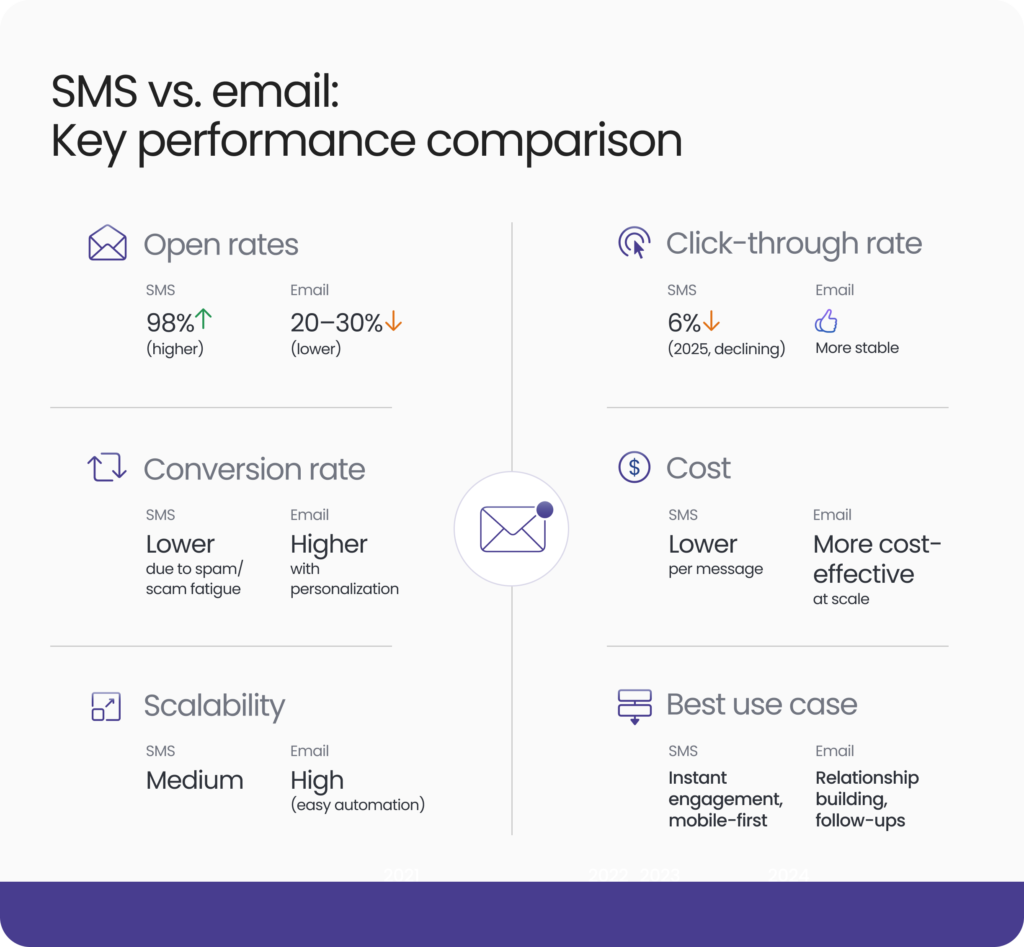
How to request reviews: A multi-channel approach
When it comes to SMS vs. email review requests, the best strategy might be: why not both?
Combining these two review request channels helps you maximize reach and response by engaging customers at the right moments in different ways:
- Use SMS for instant engagement—right after a purchase or visit
- Use email for thoughtful follow-ups and richer customer interaction
By blending the speed of SMS with the storytelling power of email, businesses can significantly boost review collection and improve overall customer experience.
Win More Customers with Birdeye Review Generation
Want to see the impact of Birdeye on your business? Watch the Free Demo Now.
Additional tips for using a combination of SMS and email
✅ Send review requests at the right time: Timing matters. Send SMS right after a service, and email a day or two later. Hitting customers while the experience is fresh increases the likelihood of a response.
✅ Keep it personal and friendly: Personalization increases the chance of a response—use customer names, order details, or recent experiences. A message that feels human stands out and builds trust instantly.
✅ Craft a compelling CTA: Whether it’s “Leave a quick review” or “Tell us what you think,” your CTA should be clear and inviting. A strong CTA eliminates hesitation and tells customers exactly what to do next.
✅ Always follow up (nicely): One reminder (especially via email) can double your review count without annoying your customers. Learn how to generate reviews through polite follow-ups that boost responses.
✅ Use automation tools to scale: Manually managing review requests is time-consuming and inconsistent. Using advanced review software helps you automate review requests across both SMS and email. This ensures perfect timing, consistent messaging, and real-time tracking.
Frequently asked questions about SMS vs. email review requests
SMS generally sees higher open and response rates in 2025, while email remains effective for more detailed messages and specific customer segments. A multi-channel approach is often the most effective way to maximize reach and results.
Yes, both channels can be fully automated using review platforms like Birdeye. Automation helps scale requests while ensuring consistent timing and messaging.
Keep the subject line clear, personalize the message, and send it within 24–48 hours of the customer interaction. Adding a direct link to the review page also boosts responses.
Send messages shortly after the customer interaction, keep the text concise, and include a short, trackable review link.
How Birdeye helps businesses with a multi-channel review request strategy
Birdeye’s Reviews AI makes it easy to send automated, personalized review requests via both SMS and email. It integrates seamlessly with your CRM and ensures your requests go out at just the right time.
- Automated review requests: Birdeye takes the manual work out of review collection by automating requests via SMS and email. As soon as a customer completes a transaction, a review invite is triggered. This makes it easy for happy customers to leave feedback without extra steps.
- Unified review dashboard: With Birdeye, you can view and manage reviews across all platforms, including Google, from one single place. This unified view helps you stay on top of customer sentiment and respond faster.
- Respond to reviews strategically: Birdeye’s AI response feature helps you draft relevant replies to reviews with just one click. Whether it’s positive or negative feedback, the AI suggests thoughtful responses that save time and help strengthen your brand reputation over time.
This way, by supporting a dual-channel approach to SMS vs email review requests, Birdeye helps businesses capture more customer feedback and build a stronger online reputation.
Ready to streamline your review strategy?

Originally published









